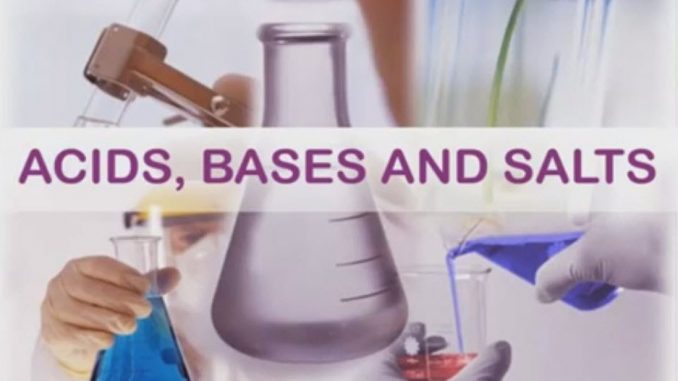
One hundred and fifteen different elements have been discovered so far, which combine to form a huge number of compounds. On the basis of their chemical properties, all the compounds can be classified into three groups:
- Acids
- Bases
- Salts
Indicators for tasting acid and base: An indicator is a ’dye’ that changes color when it is put into an acid or base. i.e. an indicator gives different colors in acid and base. The three most common indicators to test for acids and bases are; litmus, methyl orange and phenolphthalein.
- Acids (properties):
- An acid is a chemical substance which dissociates (or ionizes) on dissolving in water to produce hydrogen ions (H+ ions).
- They have a sour taste.
- They turn blue litmus to red, methyl orange gives red color in acid solution and phenolphthalein is colorless in acid solution.
- Acid solutions conduct electricity (they are electrolytes).
- Acid reacts with metals to form hydrogen gas.
Metal + acid ——-> salt + hydrogen gas
e.g. Zn(s) + H2SO4(aq) ——-> ZnSO4(aq) + H2(g)
- Acids react with metal carbonates (metal hydro carbonates) to form carbon dioxide gas.
Metal carbonate + acid ——-> salt + carbon dioxide + water
Metal bicarbonate + acid —–> salt + carbon dioxide + water
e.g. Na2CO3(s) + 2HCl(aq) ——-> 2NaCl(aq) + CO2(g) + H2O(l)
NaHCO3(s) + HCl(aq) ——-> NaCl(aq) + CO2(g) + H2O(l)
- Acids react with bases (or alkalis) to from salt and water.
Acid + base ——-> salt + water
e.g. HCl(aq) + NaOH(aq) ——-> NaCl(aq) + H2O(l)
- Acids react with metal oxides to form salt and water
Metal oxide + acid ——-> salt + water
e.g. CuO(s) + 2HCl(aq) —–> CuCl2(aq) + H2O(l)
- Acids are corrosive in nature. They cause severe burns on the skin and attack and eat up materials like cloth, wood, metal structures and stonework.
*Acids are never kept and stored in metal containers as they gradually corrode and eat up the metal container.
- Strong acids: An acid which is completely ionized in water and thus produces a large amount of hydrogen ions is called a strong acid. All mineral acids except carbonic acid (H2CO3) and suphurous acid (H2SO3) are strong acids. e.g. HCl, HNO3, H2SO4
- Weak acids: An acid which is partially ionized in water and thus produces small amount of hydrogen ions is called a weak acid. All organic acids are weak acids. e.g. acetic acid (CH3COOH), citric acid, tartaric acid etc.
- Bases (properties):
- A chemical substance that produces hydroxide ions (OH– ions) when dissolved in water is called a base. Bases are oxides and hydroxides of metals or electropositive radical which neutralizes acids.
- Water soluble bases are called alkalis. So, when we talk of a base in these discussions, it will actually mean a water soluble base or alkali. e.g. sodium hydroxide (NaOH), potassium hydroxide (KOH) etc.
- Bases are bitter in taste and they feel soapy to touch.
- They turn red litmus to blue, methyl orange gives yellow color in basic solution and phenolphthalein gives pink color in basic solution.
- Bases conduct electricity in solution (they are electrolytes).
- Bases react with acids to from salt and water.
Base + acid ——-> salt + water
e.g. 2NaOH(aq) + H2SO4(aq) ——-> Na2SO4(aq) + H2O(l)
- Bases react with non-metal oxides to form salt and water.
Base+ non-metal oxide ——-> salt + water
e.g. Ca(OH)2(aq) + CO2(g) ——-> CaCO3(s) + H2O(l)
- Strong bases: A base which completely ionizes in water and thus produces a large amount of hydroxide ions (OH–) is called a strong base or a strong alkali. e.g. KOH, NaOH etc.
- Weak bases: A base which is partially ionized in water and thus produces a small amount of hydroxide ions (OH–) is called a weak base. e.g. NH4OH, Ca(OH)2, Mg(OH)2
* Only water soluble bases are alkalis, e.g KOH, NaOH, Mg(OH)2 , but there are bases e.g. HgO, CuO which are not water soluble. Hence, all alkalis are bases but all bases are not alkalis.
- Salts (properties):
- A salt is a chemical substance formed by the partial or complete replacement of the hydrogen atom (s) of and acid, by a metal or an electropositive radical.
e.g. NaCl, K2SO4, NaNO3 etc
- Many salts are soluble in water which can be electroysed.
- The salts of strong acids and strong bases are generally neutral.
e.g. NaCl (from NaOH and HCl), K2SO4 (from KOH and H2SO4)
- The salts of strong acids and weak bases are acidic salts.
e.g. ZnSO4 (from H2SO4 and Zn(OH)2)
- The salts of weak acids and strong bases are basic salts.
e.g. Na2CO3 (from H2CO3 and NaOH)
- The salts of weak acids and weak bases are also neutral.
e.g. CH3COONa (from CH3COOH and NH4OH)
Preparation of salts:
- Direct combination of elements (metals and non-metals):
e.g. 2Na(S) + Cl2(g) ——-> 2NaCl(s)
- Action of acid on metals:
e.g. Zn(s) + H2SO4(aq) ——-> ZnSO4(aq) + H2(g)
- By the reaction of acid with metal oxides:
e.g. MgO(s) + H2SO4(aq) ——-> MgSO4(aq) + H2O(l)
- By the neutralization of acid by base:
e.g. 2NaOH(aq) + H2SO4(aq) —–> Na2SO4(aq) +2H2O(l)
- By the action of acid on metallic carbonates and bicarbonates:
e.g. CaCO3(s) + 2HCl(aq) ——-> CaCl2(aq) + H2O(l) + CO2(g)
Ca(HCO3)2(aq) + 2HCl(aq) ——-> CaCl2(aq) + 2H2O(l) + CO2(g)